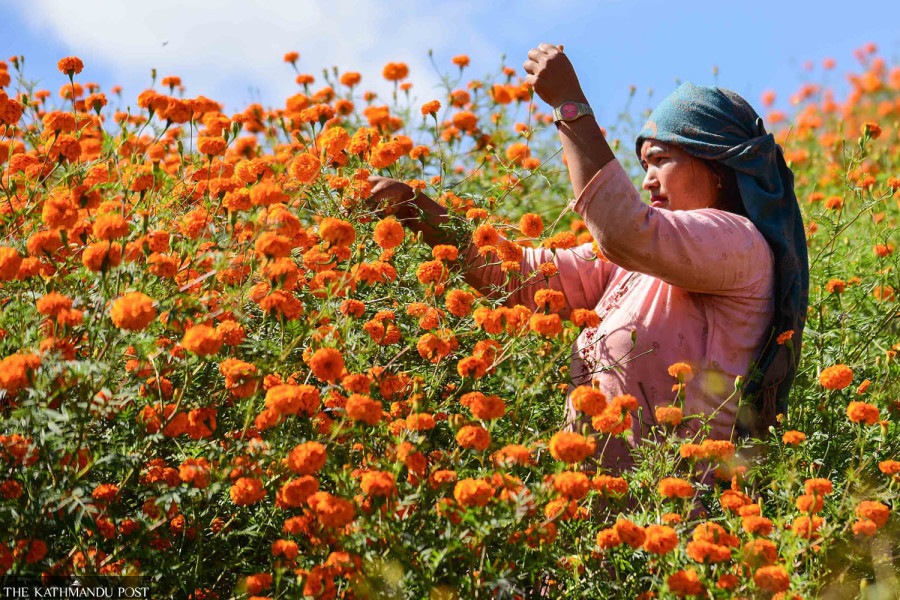National
Nepali flower farmers thrive as Indian imports restricted during Tihar
High demand fuels earnings for marigold, globe amaranth, and chrysanthemum farmers.
Seema Tamang
As Tihar begins, Nepali farmers cultivating marigold, globe amaranth (Makhamali), and chrysanthemum (Godavari) flowers are working tirelessly to meet rising demand. Last year, significant imports from India limited the sale of local marigold garlands to only around 900,000 pieces, despite the Floriculture Association Nepal (FAN) estimating demand for domestic garlands at around three million.
This demand imbalance left only 30 percent of locally grown flowers sold, with 70 percent wasted. On the other hand, 2.1 million imported marigold garlands were sold, according to FAN data.
Sundar Nepal, a farmer from ward 6 of Bidur Municipality, Nuwakot, said unsold flowers and low prices last year led him to sell directly to local traders this season. After five years of flower farming, he had anticipated earnings of Rs200,000 last year but made only Rs30,000 due to market challenges.
“This year, I’ve already earned Rs200,000, and I could make an additional Rs200,000 if rates remain stable,” he said. “Unlike last year, when I transported my flowers to Kathmandu, I could sell everything locally this time around.”
The association projects around Rs371.8 million worth of garlands—approximately 4.5 million marigold, globe amaranth, chrysanthemum, and mixed garlands—will be sold this Tihar, compared to sales of Rs274.6 million last year. Initially, FAN anticipated demand for 4.4 million garlands, with 2.5 million sourced locally and 1.5 million imported from India. However, the Plant Quarantine and Pesticide Management Centre did not permit marigold imports this season, although there are reports of limited sales of imported flowers in Lalitpur, said FAN’s former president Min Bahadur Tamang.
“The government hasn’t authorised imports, but some Indian flowers have reportedly been sold in Lalitpur,” he said. “Kathmandu Metropolis has conducted market inspections to prevent imported flowers from entering the city market.”
Yam Bahadur Hamal, a farmer in ward 2 of Golanjor Rural Municipality, Sindhuli has already sold 1,500 kilograms of marigolds. “Right after Dashain, marigold was sold at Rs300 per kilogram; now the rate has dropped to Rs150,” he said, having returned from the Kalimati wholesale market. “This season is better than the last. I’ve already sold flowers worth Rs350,000,” said Hamal, who also grows chillies, cauliflower, and cabbage.
Wholesale prices for marigold and globe amaranth garlands may increase further this season. Last Tihar, marigold garlands sold for Rs65 each.
Domestic marigold production has declined this season due to huge rainfalls in the last week of September, which caused substantial crop damage, raising concerns about a garland shortage. Current production, however, appears sufficient to meet demand.
Nepal has reached self-sufficiency in globe amaranth and chrysanthemum production, which should limit price fluctuations. Last year, globe amaranth garlands sold for Rs42.65 each, while this year’s price is estimated at Rs45.




 15.12°C Kathmandu
15.12°C Kathmandu















